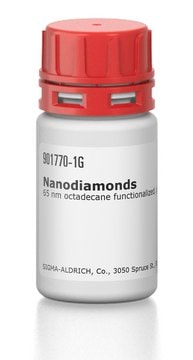774510
Titanium(IV) oxide
nanowires, diam. × L ~100 nm × 10 μm
Sinonimo/i:
Titania nanofibers, Titania nanowires, Titanium dioxide nanofibers, Titanium dioxide nanowires, Titanium(IV) oxide nanofibers, Titania, Titanium dioxide
About This Item
Prodotti consigliati
Forma fisica
nanowires
diam. × lung.
~100 nm × 10 μm
Punto di fusione
>350 °C (lit.)
Densità
4.26 g/mL at 25 °C (lit.)
Stringa SMILE
O=[Ti]=O
InChI
1S/2O.Ti
GWEVSGVZZGPLCZ-UHFFFAOYSA-N
Cerchi prodotti simili? Visita Guida al confronto tra prodotti
Applicazioni
Nota sulla preparazione
Codice della classe di stoccaggio
13 - Non Combustible Solids
Classe di pericolosità dell'acqua (WGK)
nwg
Punto d’infiammabilità (°F)
Not applicable
Punto d’infiammabilità (°C)
Not applicable
Certificati d'analisi (COA)
Cerca il Certificati d'analisi (COA) digitando il numero di lotto/batch corrispondente. I numeri di lotto o di batch sono stampati sull'etichetta dei prodotti dopo la parola ‘Lotto’ o ‘Batch’.
Possiedi già questo prodotto?
I documenti relativi ai prodotti acquistati recentemente sono disponibili nell’Archivio dei documenti.
I clienti hanno visto anche
Articoli
Dye-sensitized solar cells (DSCs) are 3rd generation solar cells combining the promise of high efficiency with low production costs.
Among various ceramics, one-dimensional (1-D) piezoelectric ceramics have attracted significant scientific attention for use in energy harvesting.
TiO2 exhibits wide band gap semiconductor and memristor properties electronically, with high opacity and UV absorbance optically.
Catalytic water splitting produces hydrogen crucial for renewable energy, petroleum refining, and chemical industry applications like methanol production.
Il team dei nostri ricercatori vanta grande esperienza in tutte le aree della ricerca quali Life Science, scienza dei materiali, sintesi chimica, cromatografia, discipline analitiche, ecc..
Contatta l'Assistenza Tecnica.





